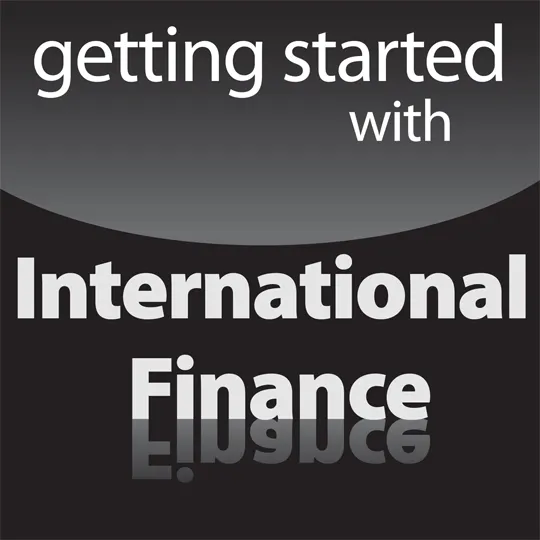Part I
Getting Started with International Finance
Visit
www.dummies.com for great Dummies content online.
In this part . . .
I start you off with a look at how international finance touches so many aspects of daily lives around the world.
I give you an introduction to the most important subject in international finance: the exchange rate. I share some very handy basic information on exchange rate lingo and calculations.
You get to meet the users of the foreign exchange market and understand what risks they face.
I introduce a visual approach to changes in exchange rates.
Chapter 1
Money Makes the World Go ’Round
In This Chapter
Understanding the terminology associated with exchange rates
Identifying the factors that change the exchange rate
Realizing excessive short-run volatility in the exchange rate and hedging against it
Examining alternative exchange rate regimes
International finance is a vast and, at times, complex subject. My goal is to break it down for you into easy-to-manage parts. Although on the surface international finance may seem a daunting subject to learn, it really is fascinating and can help you understand the world of exchange rates. Time to get started!
This chapter aims to inform you about what’s to come throughout this book. Each section in this chapter corresponds to each of the five parts of the book and gives you a glimpse of what each part covers.
Checking Out Definitions and Calculations
When learning about any new subject, gaining a basic understanding of the important terminology and, whenever applicable, calculations is important. This fact is also true for international finance. The main subject in international finance is exchange rates. Therefore, Part I includes chapters that cover the basic knowledge of exchange rates, which involves their definition, calculations, and the use of correct terminology when exchange rates change. Among the calculations-related subjects, you’ll read about how to calculate the percent change in exchange rates as well as how to convert an amount of money denominated in a currency into a different one. It turns out that all sorts of international business pros, as well as investors (or speculators), care about the changes in exchange rates.
What’s an exchange rate?
An exchange rate (also known as the nominal exchange rate) represents the relative price of two currencies. For example, the dollar–euro exchange rate implies the relative price of the euro in terms of dollars. If the dollar–euro exchange rate is $0.95, it means that you need $0.95 to buy €1. Therefore, the exchange rate simply states how many units of one currency you need to buy one unit of another currency.
Throughout the book, you see the term
consumption basket. Basically, think about the content of your shopping cart when you go grocery shopping, such as milk, bread, eggs, and so on. The consumption basket of a country includes goods and services that are bought or consumed by the average person in this country.
Other types of exchange rates also exist, including the real and effective exchange rates. The real exchange rate, for example, uses the nominal exchange rate and the ratio of the prices of two countries’ consumption baskets in respective currencies. In this case, the real exchange rate compares the price of two consumption baskets in a common currency. Therefore, unlike the nominal exchange rate, which only implies the exchange of currencies, the real exchange rate compares the price of two countries’ consumption baskets. The effective real exchange rate considers the comparison of the price of the home consumption basket to that of the weighted-average price of the most important trade partners of the home country.
What do you say when the exchange rate changes?
Using the proper terminology is important when referring to a change in the exchange rate. It’s true that this terminology relates to the exchange rate regime in question. I discuss alternative exchange rate regimes much later, in Part IV. For now, you can think of a floating (or flexible) regime and a pegged regime. In a floating exchange rate regime, mostly market forces determine exchange rates — in other words, the sale and purchase of the relevant currencies affect exchange rates. I ignore the nuances among the pegged exchange rate regimes for now and state that, for the most part, governments set the exchange rate in pegged exchange rate regimes.
An exchange rate regime implies whether or how a country decides to manage its currency with respect to other currencies. In a flexible exchange rate regime, the country leaves the determination of its currency’s price mostly to international foreign exchange markets. Alternatively, a country may decide to exercise varying degrees of control over the exchange rates involving its currency. Chapters in Part IV discuss the factors that affect countries’ decisions regarding the exchange rate regime.
Appreciation and revaluation have the same meaning: The value of one currency increases against the other. But these terms are used for the floating and pegged exchange rate regimes, respectively. For example, both the dollar and the euro are floating currencies. If the dollar–euro exchange rate decreases from $0.95 to $0.85, it implies appreciation of the dollar. If China decreases the yuan–dollar exchange rate from CNY6.23 to CNY6.02, it’s revaluation because China pegs its currency. In both cases, you need less of the domestic currency to buy one unit of the foreign currency.
Depreciation and devaluation also have the same meaning: The value of one currency decreases against the other. Again, these terms are used for the floating and pegged exchange rate regimes, respectively. If the dollar–euro exchange rate increases from $0.95 to $1.05, it implies depreciation of the dollar. If China increases the yuan–dollar exchange rate from CNY6.23 to CNY6.35, it’s devaluation. In both cases, you need more of the domestic currency to buy one unit of the foreign currency.
Who cares about exchange rates?
First, various multinational firms care about the changes in exchange rates. Some domestic firms export to or import from other countries. Some firms have licensing and franchising agreements with foreign firms. Some have production facilities in foreign countries, with or without local partners. The important point about international business is that these firms have account payables or receivables in foreign currencies. A change in the exchange rate makes their payables or receivables in domestic currency smaller or larger in terms of their home currency.
Multinational companies cannot ignore the changes in exchange rates, but as an investor, you can, if you want to. You may not follow the changes in exchange rates if your portfolio consists of domestic equity and debt securities. But if you have foreign assets in your portfolio or you’re a speculator trying to make a profit by buying currency low and selling high, you’ll be very interested in which direction and how much exchange rates change.
Finding Out What Determines (Or Changes) Exchange Rates
You may know today’s dollar–euro exchange rate. But it will be something else next year. How do you predict what the exchange rate will be? Which factors are helpful in predicting the change in exchange rates? Part II of this book focuses on these important questions.
Which model to use?
In this book, I show you two alternative ways of looking at exchange rate determination. First, you can apply a microeconomic approach to exchange rate determination and assume that currencies are exchanged just like oranges. The question as to how many oranges do y...
















